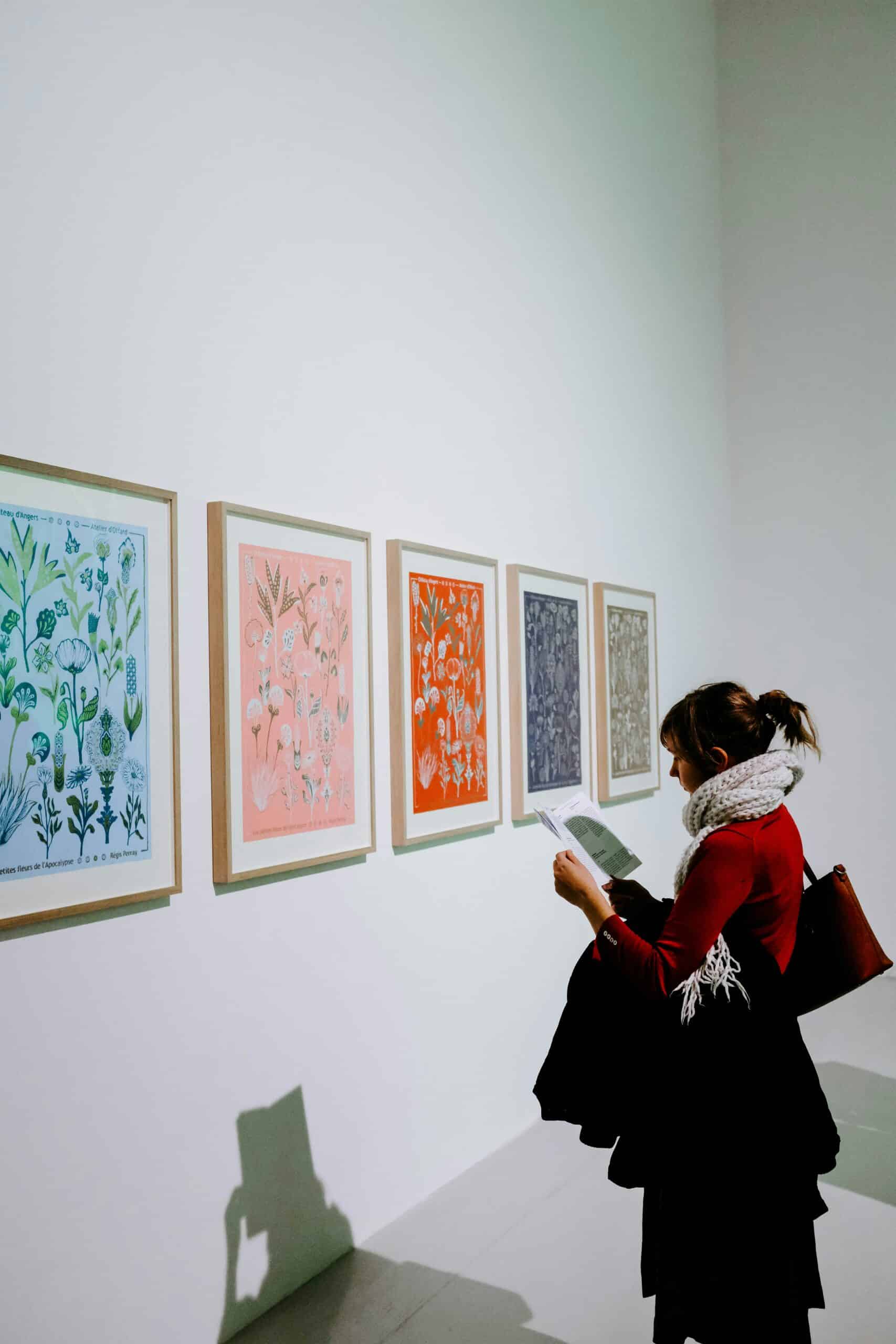Art galleries, while creative, can still be governed with the same amount of red tape as any administration–this is the due diligence necessary to protect an institution’s reputation. This means that for opportunities like art submissions, grants, and exhibitions, no matter how impressive or talented they are, artists who don’t check the required boxes can be disqualified on the basis of a technicality.
This article will help you decode the etiquette and attract representation who will support your practice, and champion your work.
Why Gallery Representation is so Important for Artists
Exhibiting your work in a gallery has tangible benefits for accelerating your career as an artist, such as:
- Increasing your exposure in your community and beyond
- Providing further access to resources and physical spaces
- Opening the door for networking opportunities
- Strengthening your credibility for future proposals and applications
The type of gallery you associate yourself with should be an intentional choice. Not every gallery is the same–their drive and programming should determine your interest because it will definitely decide your suitability
Keep reading to learn about gallery types and the differences between them.

Navigating the Art Gallery Scene and Gallery Types
Like any business, art galleries each have their own demographic of clients. Part of the job of the curator or gallery manager is to bring in artwork that will resonate with their client base. Most art galleries fall into categories of commercial, non-profit, or pop-up:
- Commercial art galleries exist to sell the artists’ work to generate a commission for themselves and profit for the artist.
- Non-profit art galleries may rely on funding or donations to operate, and their programming may specialize by location (ie: a city gallery), artist career level, or medium.
- Pop-up art galleries exist in temporary spaces like empty retail storefronts or in public places, depending on who is organizing them, and are often run in agreement with landlords and stakeholders. Additionally, pop-up galleries can be tied to other events, like festivals and art fairs.
While high-end galleries may occasionally take on lesser known artists, it’s more likely that you’ll have to reach a level of recognition before approaching these galleries.
Watch Out for Vanity Galleries
It can be really exciting to have a gallery reach out to you, but it’s important to pause and do some research of the gallery before responding. This is because, unfortunately, some galleries prey upon emerging artists desperate to increase their exposure.
These “Vanity Galleries” are legitimate businesses that extend artists a contract as agreement for displaying their work in exchange for money. More often than not, the cost does not pay off for the artist, and the relationship carries zero prestige to help forward one’s professional career because credible galleries have a poor view of transactional ones like vanity galleries. As such, it is best to avoid entering into a contract with a vanity gallery.
When a gallery approaches you, it’s reasonable to ask for a contact with a previously represented artist to see if they’re happy with their experience before signing. In addition, read all the terms and conditions thoroughly to avoid committing yourself to unpleasant financial clauses.
Once you have a good idea of the type of exhibition opportunity right for you, the next step is compiling a list of local galleries that fit that description and setting up a strong, multi-faceted digital presence for you and your art.
Create an Online Presence Before Submitting Art to Galleries
The first thing art gallery directors will do after viewing your application is Google you. In having an online portfolio site, with strong SEO, you can control much of the content they land on, positioning yourself as an artist ready for their gallery debut.
Your portfolio website gives you the opportunity to master the important skill of curation; while it can be tempting to throw on every project, presenting your best work will go farther to demonstrate your skill and professionalism. By curating your portfolio website, you’ll strengthen the editing skills necessary for putting together submission packages and applications.
Having an online art portfolio is essential when it comes to marketing yourself and submitting work to galleries, granting bodies, and residencies. Having ownership over your website gives you control over the platform showcasing your work—think of it as a gallery of your own, curated by you.
Tips for portfolio site success:
- Buy a custom website domain; they’re relatively inexpensive and will carve out your (cyber) space and stake claim to your name.
- Include a bio, artist statement and your CV where you’ve had your art shown before—even a school exhibition counts. Don’t forget to include any press mentions.
- Display at least two projects and more than 15 images
- Link back to your social media–most platforms integrate this link, ensuring it’s present on every page.
Need inspiration? Check out how fellow artists have set up their pages.
Thousands of customizations to match your unique style.
Customize your site to tell the story of your brand. Format has nearly 100 templates offering thousands of design variables.
Finding the Right Gallery to Exhibit Your Work
Once you have decided the type of gallery in which you want to show your work, it’s time to create a list of galleries that you think would be a good fit for your work, style, and level of experience. Below are five things you should research before approaching any art gallery.
1. Visit Each Gallery on Your List
Take note of the work you’re seeing in each gallery. Certain galleries and curators may have a specific taste or favor a certain style in the work they select. Familiarize yourself with the past and current exhibitions at galleries you’re interested in, and ask yourself some questions like:
- Does my work have a new or interesting perspective?
- Do I use specific materials or techniques?
- Is my body of work cohesive and consistent?
- What is the inspiration behind my work?
The answers to these questions will help you decide if your art aligns with the themes, styles, and media typically displayed at the gallery before submitting.
2. Attend Openings and Events at Galleries Open to Submission
You need to be active in the art community in general, but especially if you’re submitting work to galleries in the community. Attending gallery openings and exhibition launches will put you on the radar, and show your support for your local art scene. Get to know your peers, and make friends! Artists you are drawn to, or with whom you have themes in common, may make perfect exhibition partners. Putting together a submission with another artist already in mind, or as part of the proposal, will be more convincing than a solo show.
3. Become a Regular at Galleries, Especially One Aligned to Your Work
Regularly visiting local art galleries, outside of an opening vernissage, will be a great opportunity to introduce yourself to gallery owners, managers and curators. Some art galleries seeking new artists do not post calls for artist submissions, and the only way in is through a referral. Take the time to build genuine relationships to foster support from other artists and gallery decision-makers.
4. Familiarize Yourself with Each Gallery’s Processes and Preferences
A great way to signal to a gallery that you are interested in getting involved is to demonstrate that you know about its artist application processes–some may make open calls to align to festivals or art fairs only (as they may showcase their main talent at the fair). In addition, document each gallery submission guidelines and deadlines. Showing that you are aware of the gallery’s guidelines will give you a better chance of being selected.
5. Learn Who’s Who at the Art Gallery
Understanding the hierarchy at your desired gallery will make it easy to direct your questions and inquiries to the right person. Galleries often employ following roles:
- Gallery Assistant runs the day-to-day open and close of the gallery, and is on hand for questions from visitors
- Gallery Curator oversees artist selection and presentation of exhibitions
- Gallery Director manages operations, staff, and finances
- Gallery Owner holds ownership and decision-making power
Every gallery is as unique as its people, so knowing how the organization is run will work to your advantage when trying to get your foot in the door.
Now that you are armed with the right information, it’s time to reach out to your chosen gallery. This is done through a Letter of Inquiry.
How to Write a Letter of Inquiry
While writing a Letter of Inquiry might seem intimidating, there’s a simple standardized formula for writing one. It should include:
- Curator’s first and last name
- An outline of your artistic background, no longer than 200 words
- Your artist’s statement
- Links to your online portfolio, website, and social media channels
- Explanation of why you think your art is a good fit for their gallery–citing past exhibitions and artists on their roster
Export your document as a PDF to keep the formatting consistent between recipients. When emailing the gallery curator, start with a short introduction of yourself in the body of the email, directing them to the Letter attachment. You should be able to find the curator’s contact information through the gallery website, or networking.
Following up on Your Letter of Inquiry
Politely follow up in two weeks if you haven’t heard back. Remember to be courteous, no matter the verdict. Word travels fast in the art world, so always be respectful and kind when dealing with galleries–and, as a general rule, anyone. Make sure to express gratitude for any input you receive on your artwork as they have taken the time to really look and respond to your submission.
Proposing exhibitions involves trial and error, as well as rejection. Don’t be discouraged, this is normal and can come at any stage in a career. Take advice and feedback to refine your next try.
Provide and Follow Art Gallery Submission Instructions Exactly
If you have successfully secured an exhibition, always prepare your art according to the submission instructions provided by the gallery. It’s important to make it easy for them to install your work. Your work should be labeled, with measurements, year, medium, and your name–of course. There should be hanging or installation hardware included, ie: d-rings on canvases and frames, or mount bars for screens. Galleries will note if your work is clear and easy to install.

How Artist Resources and Grants Can Help Get Your Art Into a Gallery
The arts are an important cultural investment, and often receive support from various levels of government. A great place to find open calls for artist submissions is through your municipal arts council. State and federal arts councils also provide an online network for finding opportunities and resources to get your art exhibited.
Purchasing the supplies you need to create your art as well as display and transport it properly for every exhibition can add up. You may also apply for art council grant programs to help you fund and fuel local creative projects. Here are some tips on how to write a better artist grant application.
Learn to Sell Art With an Elevator Pitch
Developing an elevator pitch for yourself that strongly advocates for your art can make every difference in presenting your work. The purpose of an elevator pitch is to convey the meaning of your proposal in 30 seconds or less–the average time spent in an elevator, and the average time someone is willing to listen to your idea or description of your practice.
Refine how you speak about yourself and your work into something both short, but organic. You’re not a cereal developing a slogan, you’re just taking your artist statement and giving it a tldr summary.
As you develop your pitch, practice talking about your art, your inspiration, and your themes with confidence. If you aren’t excited about your art, it’s going to take more effort to get your audience to pay attention.
Be prepared to give your social media or portfolio url at any time.
How to Sell Your Art in a Gallery and Make a Profit
The gallery will invest time and resources in promoting your work, since they will take in 30-50% of the sales price. To do your part,
- Promote the gallery on your social media channels
- Get as many people to your vernissage as possible–friends, family, interested buyers, cool customers from the cafe you work at–especially those who are interested in art-collecting
- Include the gallery and a key contact in your press releases
Remember to price your work keeping in mind material costs, your time, and the commission that the gallery will take. It’s important to recognize the gallery commission as the funds necessary to rent that space, pay the team for taking care of all logistics and marketing your work.
Taking the Next Step
Navigating the gallery world has its challenges, particularly given the strict protocols that can often hinder talented artists from gaining the recognition they deserve. In absorbing insights from and following steps in this article, you can demystify the process of gaining the right gallery representation and fulfill your dream of seeing your work in an exhibition.
If you want some inspiration to begin establishing your digital presence, check out these Format online portfolio templates built with artists in mind.
Build Your Portfolio With Format
Rated #1 online portfolio builder by artists and makers.












